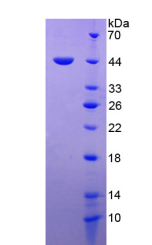Active Macrophage Migration Inhibitory Factor (MIF) 

GIF; GLIF; MMIF; Glycosylation-Inhibiting Factor; L-dopachrome isomerase; L-dopachrome tautomerase; Phenylpyruvate tautomerase
- UOM
- FOB US$ 322.00 US$ 806.00 US$ 1,612.00 US$ 4,836.00 US$ 12,090.00
- Quantity
Overview
Properties
- Product No.APA698Hu02
- Organism SpeciesHomo sapiens (Human) Same name, Different species.
- ApplicationsCell culture; Activity Assays.
Research use only - DownloadInstruction Manual
- CategoryCytokineInfection immunityRheumatologyAutoimmunity
- Buffer Formulation20mM Tris, 150mM NaCl, pH8.0, containing 1mM EDTA, 1mM DTT, 0.01% SKL, 5% Trehalose and Proclin300.
- Traits Freeze-dried powder, Purity > 95%
- Isoelectric Point6.6
Sign into your account
Share a new citation as an author
Upload your experimental result
Review

Contact us
Please fill in the blank.
Activity test

Figure. The binding activity of MIF with MHCDG.
Macrophage migration inhibitory factor (MIF), also known as glycosylation-inhibiting factor (GIF), L-dopachrome isomerase, or phenylpyruvate tautomerase is a protein classified as an inflammatory cytokine. MIF is an important regulator of innate immunity. It involved in cell-mediated immunity, immunoregulation, and inflammation. MIF plays a role in the regulation of macrophage function in host defense through the suppression of anti-inflammatory effects of glucocorticoids. This lymphokine and the JAB1 protein form a complex in the cytosol near the peripheral plasma membrane, which may indicate a role in integrin signaling pathways. Besides, Major Histocompatibility Complex Class II Invariant Chain (MHCDG) has been identified as an interactor of MIF, thus a binding ELISA assay was conducted to detect the interaction of recombinant human MIF and recombinant human MHCDG. Briefly, MIF were diluted serially in PBS, with 0.01% BSA (pH 7.4). Duplicate samples of 100uL were then transferred to MHCDG-coated microtiter wells and incubated for 2h at 37℃. Wells were washed with PBST and incubated for 1h with anti-MIF pAb, then aspirated and washed 3 times. After incubation with HRP labelled secondary antibody, wells were aspirated and washed 3 times. With the addition of substrate solution, wells were incubated 15-25 minutes at 37℃. Finally, add 50µL stop solution to the wells and read at 450nm immediately. The binding activity of MIF and MHCDG was shown in Figure 1, and this effect was in a dose dependent manner.
Usage
Reconstitute in 20mM Tris, 150mM NaCl (pH8.0) to a concentration of 0.1-1.0 mg/mL. Do not vortex.
Storage
Avoid repeated freeze/thaw cycles. Store at 2-8°C for one month. Aliquot and store at -80°C for 12 months.
Stability
The thermal stability is described by the loss rate. The loss rate was determined by accelerated thermal degradation test, that is, incubate the protein at 37°C for 48h, and no obvious degradation and precipitation were observed. The loss rate is less than 5% within the expiration date under appropriate storage condition.
Increment services
-
 BCA Protein Quantification Kit
BCA Protein Quantification Kit
-
 Molecular Mass Marker for Protein
Molecular Mass Marker for Protein
-
 Monoclonal Antibody Customized Service
Monoclonal Antibody Customized Service
-
 Polyclonal Antibody Customized Service
Polyclonal Antibody Customized Service
-
 Protein Activity Test Experiment Service
Protein Activity Test Experiment Service
-
 Electrophoretic Mobility Shift Assay (EMSA) Experiment Service
Electrophoretic Mobility Shift Assay (EMSA) Experiment Service
-
 Buffer
Buffer
-
 Lentivirus Packaging Experiment Service
Lentivirus Packaging Experiment Service
-
 Adenovirus Packaging Experiment Service
Adenovirus Packaging Experiment Service
-
 Real Time PCR Experimental Service
Real Time PCR Experimental Service
-
 Spike RBD Protein (S-RBD)
Spike RBD Protein (S-RBD)
-
 Protein G
Protein G
-
 Protein A
Protein A
Citations
- Targeted reduction of advanced glycation improves renal function in obesityPubMed: 21412218
- Macrophage Migration Inhibitory Factor Plays a Role in the Regulation of Microfold (M) Cell-Mediated Transport in the GutJimmunol: 5673
- Involvement of exercise-induced macrophage migration inhibitory factor in the prevention of fatty liver diseasePubMed: PMC3757527
- Role of macrophage migration inhibitory factor in the regulatory T cell response of tumor-bearing micePubMed: PMC3466372
- Deletion of bone-marrow-derived receptor for AGEs (RAGE) improves renal function in an experimental mouse model of diabetesPubmed:24957662
- The Potential Role of Polymethyl Methacrylate as a New Packaging Material for the Implantable Medical Device in the BladderPubMed: 25705692
- Combined NOX1/4 inhibition with GKT137831 in mice provides dose-dependent reno- and atheroprotection even in established micro- and macrovascular disease.pubmed:28160092
- Protective effect of chlorogenic acid on the inflammatory damage of pancreas and lung in mice with l-arginine-induced pancreatitis pubmed:28919396
- Cytokine MIF Enhances Blood-Brain Barrier Permeability: Impact for Therapy in Ischemic StrokePubmed:29335619
- Immune Response and Mechanisms of IFN-γ in Administration for KeratomycosisPubmed: 30307777
- Effect of voluntary running on expression of myokines in brains of rats with depressionPubmed: 30834799
- Biomarkers in Heart Failure and Associated Diseases
- Autophagy mediates the secretion of macrophage migration inhibitory factor from cardiomyocytes upon serum-starvationPubmed: 31209799
- Beneficial effects of voluntary over forced exercise on skeletal muscle structure and myokines expressionPubmed: 31802473
- Deletion of macrophage migration inhibitory factor ameliorates inflammation in mice model severe acute pancreatitisPubmed: 32062385
- Association between MIF gene promoter rs755622 and susceptibility to coronary artery disease and inflammatory cytokines in the Chinese Han population33850223
- Macrophage migration inhibitory factor is overproduced through EGR1 in TET2low resting monocytesPubmed:35115654








